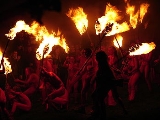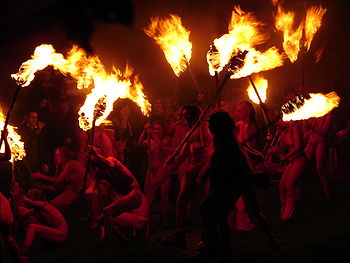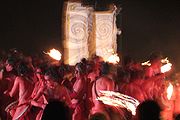
Beltane Fire Festival
Encyclopedia

Calton Hill, Edinburgh
Calton Hill is a hill in central Edinburgh, Scotland, just to the east of the New Town. Views of, and from, the hill are often used in photographs and paintings of the city....
in Edinburgh
Edinburgh
Edinburgh is the capital city of Scotland, the second largest city in Scotland, and the eighth most populous in the United Kingdom. The City of Edinburgh Council governs one of Scotland's 32 local government council areas. The council area includes urban Edinburgh and a rural area...
.
Historical background
The modern Beltane Fire Festival is inspired by the ancient GaelicGaels
The Gaels or Goidels are speakers of one of the Goidelic Celtic languages: Irish, Scottish Gaelic, and Manx. Goidelic speech originated in Ireland and subsequently spread to western and northern Scotland and the Isle of Man....
festival of Beltane
Beltane
Beltane or Beltaine is the anglicised spelling of Old Irish Beltaine or Beltine , the Gaelic name for either the month of May or the festival that takes place on the first day of May.Bealtaine was historically a Gaelic festival celebrated in Ireland, Scotland and the Isle of Man.Bealtaine...
which began on the evening before May 1 and marked the beginning of summer. The modern festival was started in 1988 by a small group of enthusiasts including the musical collective Test Dept
Test Dept
Test Dept were an industrial music group from London, one of the most important and influential early industrial music acts. Their approach was marked by a strong commitment to radical socialist politics.-History:...
, with academic support from the School of Scottish Studies at the University of Edinburgh
University of Edinburgh
The University of Edinburgh, founded in 1583, is a public research university located in Edinburgh, the capital of Scotland, and a UNESCO World Heritage Site. The university is deeply embedded in the fabric of the city, with many of the buildings in the historic Old Town belonging to the university...
. Since then the festival has grown, and as of 2006 involved over 300 voluntary collaborators and performers with the 11,500 available tickets selling out.
While the festival draws on a variety of historical, mythological and literary influences, the organisers do not claim it to be anything other than a modern celebration of Beltane, evolving with its participants.
Modern festival

University of Edinburgh
The University of Edinburgh, founded in 1583, is a public research university located in Edinburgh, the capital of Scotland, and a UNESCO World Heritage Site. The university is deeply embedded in the fabric of the city, with many of the buildings in the historic Old Town belonging to the university...
. The event was intended as a celebration and also a protest against the then Thatcher government's restrictions on rights to gather. Originally intended to take place on Arthur's Seat, the home of earlier Edinburgh Beltane celebrations, for practical reasons the location was moved to Calton Hill. Choreography, iconography and performance were moulded by the originators' research into historical accounts of Beltane and their own influences (e.g. Test Department's drumming, Trinidadian carnival, and ritual dance and performance).
The Beltane Fire Society
Beltane Fire Society
The Beltane Fire Society organises the Beltane Fire Festival on Calton Hill and the Samhuinn Fire Festival on the Royal Mile, both in Edinburgh, Scotland. The society was formed in 1988 for the second Beltane Fire Festival . The BFS also organises events for the other Celtic cross-quarter days,...
, a registered charity which runs the festival, is managed by a democratically elected voluntary committee, and all the performers are volunteers who either join by word of mouth or by attending one of the advertised open meetings held early in the year. Senior performers and artists in the society help others through workshops with aspects of event production, prop construction, character performance techniques, team building, percussion skills and the health and safety considerations involved. The society has also held fundraising art and music events and has held a 'mini-Beltane' at a local AIDS Hospice, Milestone House.
As a community event, each year the performance has evolved as new people bring their own influences and directions. The core narrative remains by and large the same though additional elements have been added over time for theatrical, ritual, and practical reasons. Originally an event with a core of a dozen performers and a few hundred audience, the event has grown to several hundred performers and over ten thousand audience. Key characters within the performance are maintained, though reinterpreted by their performers, and additional participants incorporated each year.
Originally, the festival was free and only lightly stewarded, however, as the event has grown in popularity, due to the capacity of the hill, funding requirements, and Edinburgh Council requests, the festival has in recent years moved to being a ticketed event.
Events of the festival
The main event of the festival is the procession of performers, starting at the Acropolis (National MonumentNational Monument, Edinburgh
The National Monument of Scotland, popularly referred to as Scotland's Disgrace, the Pride and Poverty of Scotland or Edinburgh's Shame, is an unfinished building on Calton Hill in Edinburgh...
), who perform a ritual drama based on some aspects of the pre-Christian festival of Beltane, and other mythologies from ancient cultures. The fertility of the land and animals is celebrated and encouraged. Led by one of the Blue Men, the procession's guides and guards, the Green Man
Green Man
A Green Man is a sculpture, drawing, or other representation of a face surrounded by or made from leaves. Branches or vines may sprout from the nose, mouth, nostrils or other parts of the face and these shoots may bear flowers or fruit...
(in winter guise) appears through the columns. Next the Neid Fire is made; this is the making of fire by traditional methods, and all fire seen on the night is produced from this first flame. The Torchbearers and Processional Drummers are next over the top of the Acropolis, followed by the White Warrior Women and finally the May Queen
May Queen
The May Queen or Queen of May is a term which has two distinct but related meanings, as a mythical figure and as a holiday personification.-Festivals:...
. A horn signals the May Queen's birth, and the drums begin. The May Queen and her White Women, four of whom are her Handmaidens, proceed to be born of the Earth, greet the (four) cardinal direction
Cardinal direction
The four cardinal directions or cardinal points are the directions of north, east, south, and west, commonly denoted by their initials: N, E, S, W. East and west are at right angles to north and south, with east being in the direction of rotation and west being directly opposite. Intermediate...
s in back bends and bow to the crowd of spectators (in three directions). After they finally acknowledge the Earth and the sky, the Green Man (who has been watching this from the ground) is allowed to approach the May Queen at the very top. She accepts him as her consort and the procession begins, led by the May Queen. The four Handmaidens, White Women bodyguards and Processional Drummers then join the May Queen and Green Man, and all are flanked by Torchbearers and Stewards and guided and protected by four Blue Men onto one of the footpaths running along the top of Calton Hill.
The footpath reaches an intersection, and the May Queen spins to decide which direction to turn in, choosing the leftward path which leads to the Fire Arch. Between the intersection and Arch, the Handmaidens and White Women stir the air with their wands, gathering the energies of the Earth, while the Drummers change rhythms to indicate the difference in purpose.
Fire Arch
At the Fire Arch, the Guardians first greet the May Queen and Green Man, and perform a dance which represents the rituals necessary to open a path into the Underworld. As the procession passes through the Fire Arch, the Handmaidens and White Women begin to keen, mourning the losses of the world over the past year. This continues until the procession reaches the Point of the Element of Air.Elemental Points
At the Air Point, performers representing the element of Air put on a display for the May Queen and Green Man and present them with a gift. Having awakened Air, the May Queen leads the procession through the point and around the side of the hill to the Earth Point, which is situated in the midst of a stand of trees on the North-eastern side of Calton Hill. More dancers and acrobats perform for the May Queen and Green Man, and they are presented with a bannock bread before the procession continues again, passing through the point and around to Water Point, on the Northern side of the hill with a view overlooking the Firth of ForthFirth of Forth
The Firth of Forth is the estuary or firth of Scotland's River Forth, where it flows into the North Sea, between Fife to the north, and West Lothian, the City of Edinburgh and East Lothian to the south...
. Again a ritual performance occurs here, including the washing of the May Queen and Green Man's faces in the "dew". After this point's gift is presented the procession heads on to Fire Point.
Again, dancers and acrobats perform and offer the May Queen and Green Man a gift. The procession wends its way down the side of the hill to a lower footpath, where the Handmaidens and White Women begin gathering the energies of the awakening Earth and sending them deep into the hill. The procession pauses below the City Observatory
City Observatory, Edinburgh
The City Observatory is an astronomical observatory on Calton Hill in Edinburgh, Scotland. It is also known as the Calton Hill Observatory....
to watch the Fire Point display on the hillside above and another gift is presented.
Once awakened by the power of the May Queen the Elements do not follow the procession but are drawn towards each other and move from their "points" towards a place where they can gather and unify, thus restoring the natural order.
Red Men
Having awakened the four elements, the May Queen guides the procession around the Western side of the hill. The first of the Red Men, imps created with the May Queen's appearance at the Monument and representing the forces of Chaos, spot the procession as it passes below and are attracted to the May Queen and her Warriors. As the procession rounds the hill, the Red Men begin to taunt the White Women, and then stage a series of charges as the procession reaches the base of the hill on the South side of the Observatory. This represents the Red Men's interest in capturing the May Queen on behalf of their lord the Green Man. The White Women ward the Red Men off in the end without 'killing' any of them as any unnecessary 'deaths' would lead to a lessening of the energies needed to bring about the change of the seasons from Winter to Summer.The Stage
The procession completes a full circle, arriving back at the path intersection, and turns to cross over the top of the hill and down into a valley where a stage has been set up for the final display. The Handmaidens perform a ritual to 'cleanse' the stage while the Torchbearers, Stewards and White Women form a circle around the open space surrounding the stage. The May Queen and Green Man mount the stage and the May Queen begins her ritual to awaken the Earth to summertime.Green Man killed
While she and her Handmaidens and the White Women begin to spin and focus the energies they have been gathering throughout the night, the Red Men are allowed to approach the stage and circle it, increasing the power further. Overcome with the May Queen's beauty and goaded by the presence of the Red Men, the Green Man can no longer resist and catches the May Queen. This act is strictly forbidden, and the Green Man is ritually killed by the Handmaidens, lifted and turned anticlockwise, his bulky Winter form stripped away and thrown to the Red Men, he is then turned clockwise and presented to the May Queen.Green Man reborn
The May Queen takes pity on the Green Man and brings him back to life, like a young sapling breaking the earth after Winter's hoarfrost is melted away. Overwhelmed by the new life that fills him the Green Man dances presenting himself to the four directions, repeating the actions of the May Queen from the beginning of the procession.The bonfire
The May Queen then crowns the Green Man and leads the procession up the hill to the bonfire, on a high Northern point overlooking the valley on the hill and the city of Edinburgh below. The White Women and Red Men surround the bonfire (making an outer and middle layer respectively) with the Handmaidens forming the innermost layer. A set of wax hands are then lit and the May Queen and the Green Man make their way into the very centre of the Reds and Whites. They walk around the bonfire with the lit wax hands three times, on the fourth circuit they light the bonfire with the flaming hands in four places. They then walk thrice more around the bonfire as the Beltane blessing is announced to the gathered people. The lighting of the bonfire signals the end of Winter and the coming of Summer, and the Green Man's Winter form is symbolically cast into the pyre. At the same time the stage is occupied by Fire Point, this symbolises the old tradition where farmers would drive their herds between two bonfires at this time of year to bless them.The Bower
Once the bonfire is lit, the procession passes through the crowds to the May Queen's Bower, on the side of the hill below and behind the Acropolis, where the procession can finally relax. The Fire Arch Guardians formally present their gift to the May Queen and Green Man, and HandfastingHandfasting
Handfasting is a traditional European ceremony of betrothal or wedding. It usually involved the tying or binding of the right hands of the bride and groom with a cord or ribbon for the duration of the wedding ceremony.-Etymology:...
s are held as the couples are blessed and jump together over the Willow-switch withies of the Blue Men, representing a commitment which will last through all trials for a year and a day.
After this, the four Elements and other groups (these vary but will usually include "No Point", that entertain spectators without being in a fixed location) formally present their gifts to the May Queen and Green Man, and the Red Men are presented before the Handmaidens and White Women. Symbolically, they seduce/are seduced by the White Women and Handmaidens, representing a union between the White Order and the Red Chaos. The rest of the performers are then invited into the Bower circle to dance and celebrate the arrival of summer, and finally so are the spectators.
External links
- Beltane Fire Society - The official BFS website
- Night Watch - The Torchbearers and Stewards of Beltane
- Azure Feast - A musical suite inspired by the Beltane Fire
- The Beltane Festival revealed - bbc.co.uk
- Behind the pomp of Beltane Festival - bbc.co.uk
- Solstice, Equinox & Fire Festival open gatherings Tara Celebrations in Ireland

